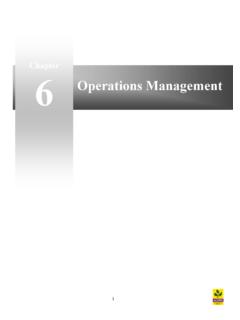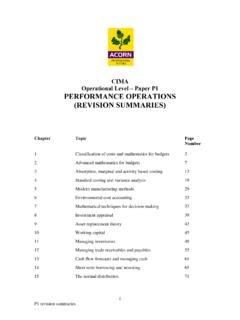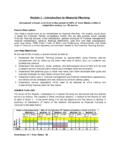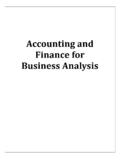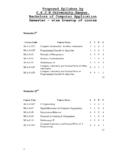Transcription of F3 - revision summaries
1 f3 revision summaries 1 CIMA Strategic Level F3 financial STRATEGY ( revision summaries ) Chapter Title Page number 1 Introduction to financial strategy 3 2 Analysing performance 7 3 Planning and forecasting 11 4 Long term finance 13 5 Cost of capital & capital structures 17 6 CAPM 21 7 Dividend policies, EMH & treasury function 25 8 Business valuation 29 9 Corporate reorganisation 31 10 Investment appraisal Part 1 37 11 Investment appraisal Part 2 43 f3 revision summaries 2 f3 revision summaries 3 Introduction to financial Strategy Chapter 1 f3 revision summaries 4 Key summary of chapter developments in external reporting financial strategy can be defined as a course of action including the specification of resources required, achieving a specific objective. An organisation has to identify its objectives.
2 Objectives are the goals or aims of an organisation, and identify what the organisation wants to achieve and what its mission is. For most profit making organisations, the main objective is to maximise shareholder wealth . Maximising shareholder wealth is done through increasing profits which can be achieved through: Increasing profitability, through cost reduction and efficiency programs Investing in profitable projects or investments Expanding through new products and new markets Acquiring or merging with other organisations The objectives of the organisation must incorporate all stakeholders and the organisation has to balance the needs of all interested parties. Once the objectives have been identified, the organisation must then plan to achieve those objectives. This will involve at looking at various options available, analysing those options, choosing the appropriate one by ensuring there are enough funds and resources available to implement the option or options.
3 Once implementation commences, it is important to monitor and control the chosen option to ensure it is consistent with objectives. This is mainly done through performance measures. There are 3 key decisions in financial management. Investment Financing Dividends These 3 key decisions are inter-related financial objectives The main financial objective is to maximise shareholder wealth, by maximising profits and cash flows, and giving maximum return. To achieve the capital growth of the share price, the company must be able to generate profits. One way that this is done is by investing in projects, which give the maximum return. Non- financial objectives The influence of the various parties with interest in the firm results in firms adopting many non- financial objectives. f3 revision summaries 5 Stakeholders To ensure that the objectives of the company look after everybody s interest, the stakeholders have to be recognised.
4 Stakeholders are those organisations or people that have an interest in the organisation, these interests are varied and for many reasons. They can be a source of potential conflict for the successful accomplishment of the organisations strategy and goals. The essential skills of negotiation and communication are needed by the organisations management team, in order to resolve conflicts that may exist between the strategic aims of the organisation and the goals, values and interests of its various stakeholders. Not for profit and public service organisations These types of organisations include public sector services, government departments, charities and voluntary organisations. The objectives of these organisations are not concerned with making a profit but with ensuring they provide their best service.
5 Whereas profit making organisations have access to finance if they require it (debt and equity), non profit making organisations have a major set back in that they have limited funds. These funds must be used to their best ability and to last for as long as possible. Demand is also factor. For profit making organisations, demand is a limiting factor (this restricts their growth). For non profit making organisations, demand is usually too much and it s their own resources which is the limiting factor. As demand is too high, this will affect the quality of service. Constraints to policy formulation and action) There are many factors which will affect the decision taken in financial strategy formulation. These factors will impact on the type and amount of finance acquired and they type of investment decision made.
6 These factors can be grouped as follows: Economic factors interest rates, inflation rates and exchange rates External constraints regulation imposed on organisation Internal constraints self imposed Corporate governance how organisations are run International issues investing overseas has an added layer of risk f3 revision summaries 6 Current and emerging issues in financial reporting Corporate collapses and accounting scandals have resulted in pressure for more information from the companies. Operating and financial review (OFR) The OFR gives details of the organisations past results and future plans, and is prepared by the senior management. The OFR is not mandatory but most listed companies produce it as part of their annual accounts. In the UK the government is intending to make the OFR mandatory for all listed companies and wants them to produce and publish it as part of their annual accounts.
7 Global reporting The global reporting initiative (GRI) was set up by the US and environmental bodies including the UN environment programme. The guidelines set out in the GRI apply to all entities that produce financial information, and its intention is to develop sustainable reporting practices to make all entities more comparable and to provide important non financial information. Environmental reporting Organisations have a huge impact on the environment, ranging from industrial pollution, gas emissions and mining. Therefore they must be accountable for how they deal with environmental issues, and in some cases are required by law to do so. Social and ethical reporting Social and ethical reporting can be both financial and non financial and covers a broad range of issues. The sociological environment is the environment that the organisation deals with.
8 It employs human resources and has an impact on the society with its decisions. It can bring wealth to the community but it could also bring pollution and destruction. Ethical reporting is increasingly becoming important, as a large number of investors will only invest in organisations adhering to ethical rules. For example unethical companies may exploit child labour, or sell arms to worn torn countries. The ethical investors group reports on unethical organisations. Human resource accounting Human resource accounting involves measuring and disclosing the value of employees or human resources to the organisation. The basic principle of human resource accounting is that, employees are assets, and competitive advantage is gained by effective use of people. f3 revision summaries 7 Analysing Performance Chapter 2 f3 revision summaries 8 Key summary of chapter analysing performance financial analysis The objective of financial statements is to provide information to all the users of these accounts to help them in their decision-making.
9 Note that most users will only have access to published financial statements. Interpretation and analysis of financial statements involves identifying the users of the accounts, examining the information, analysing and reporting in a format which will give information for economic decision making. Ratios can be grouped into 3 main areas: 1 Performance - how well the business has done (profitability) 2 Position - short term standing of the business (liquidity) 3 Potential - what the future holds for the business Exam technique for analysing performance The following steps should be adopted when answering an exam question on analysing performance: Step 1 Review figures as they are and comment on them. Step 2 Calculate relevant ratios according to performance, position and potential (if possible) 1 Performance (profitability) how well has the business done Return on capital employed (ROCE) Profit before interest & tax (PBIT) X 100% Capital employed (CE) Operating profit margin PBIT X 100% Turnover Asset turnover Turnover (number of times) Total assets (Operating profit margin x asset turnover = ROCE) Return on equity (ROE) Profit before tax_____ x 100% Shareholder funds (capital + reserves) f3 revision summaries 9 2 Position (liquidity)
10 Short term standing of the business Current ratio Current assets__ (number of times) Current liabilities Quick ratio Current assets inventory (number of times) Current liabilities Gearing - equity Debt capital ____ X 100% Equity (shareholders funds) Gearing total Debt capital_____ X 100% Debt + equity (total capital) Interest cover Profit before interest & tax (PBIT (number of times) Interest paid Trade payable days Trade payables_____ x 365 days Cost of sales (or purchases) Inventory days Inventory_ x 365 days Cost of sales Trade receivable days Trade receivable x 365 days Sales Working capital cycle Trade receivable days + inventory days trade payable days 3 Potential (investor) what investors are looking at Earnings per share (EPS) Profit after tax__ Number of shares P/E ratio Share price___ Earnings per share Dividend yield Dividend per share X 100% Share price Dividend cover Earnings per share Dividend per share f3 revision summaries 10 Step 3 Add value to the ratios by: Interacting with other ratios and giving reasons a) State the significant fact or change ( increase or decrease) b) Explain the change or how it may have occurred by looking at the business activities and other information.
